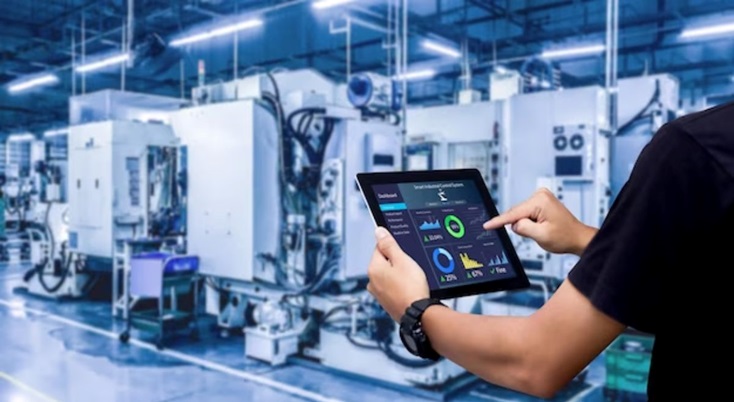How Manufacturers Can Improve Supply Chain Visibility with IoT

Manufacturers worldwide are constantly seeking ways to enhance their supply chain operations, and one of the most transformative technologies enabling this improvement is the Internet of Things (IoT). In this article, we’ll explore how manufacturers can improve supply chain visibility with IoT, leading to increased efficiency, reduced costs, and better decision-making.
Understanding IoT in Manufacturing
Connecting Devices for Enhanced Insight
The Internet of Things (IoT) is a network of interconnected gadgets and sensors that gather and share data online. In manufacturing, this technology allows machines, equipment, and even products to communicate and share information in real-time. This wealth of data can be harnessed to gain deeper insights into various aspects of the supply chain.
The Benefits of IoT in Supply Chain Visibility
Transforming Manufacturing Operations
- Real-Time Monitoring
-
- Asset Tracking: IoT sensors can track the location and status of assets, including raw materials, components, and finished products, in real time. This information helps manufacturers know precisely where their resources are at any given moment.
-
- Equipment Health: Continuous monitoring of machinery and equipment using IoT sensors allows manufacturers to predict maintenance needs and avoid unexpected downtime.
- Inventory Management
-
- Automated Inventory Tracking: IoT-powered RFID tags and sensors automate inventory management, reducing manual efforts and minimizing errors.
-
- Demand Forecasting: Real-time data on inventory levels enable better demand forecasting, ensuring that manufacturers maintain optimal stock levels and reduce carrying costs.
- Supply Chain Visibility
-
- End-to-End Visibility: IoT enables manufacturers to track products from the moment they leave the production line to their final destination, providing end-to-end visibility across the supply chain.
-
- Supplier Performance: IoT data can evaluate supplier performance, ensuring that partners meet quality and delivery standards.
- Improved Decision-Making
-
- Data-Driven Insights: IoT-generated data offers valuable insights into supply chain operations. Manufacturers can make data-driven decisions regarding routes, production schedules, and resource allocation.
-
- Real-Time Alerts: IoT sensors can trigger real-time alerts for anomalies or deviations from expected performance, allowing for immediate corrective action.
Overcoming Implementation Challenges
Navigating the Road to IoT Integration
Implementing IoT in manufacturing supply chains comes with its own set of challenges that need to be addressed effectively to ensure a successful transition.
1. Data Security
- Challenge: Ensuring the security of IoT data is paramount. With the influx of data generated by IoT devices, the risk of data breaches and cyberattacks increases.
- Solution: To counter this challenge, manufacturers should implement robust security protocols. Data should be encrypted during transmission and storage, and strict access controls should be in place to ensure that only authorized personnel can access sensitive information.
2. Compatibility
- Challenge: Integrating IoT devices into an existing technology infrastructure can be complex, as compatibility issues may arise.
- Solution: To address this challenge, manufacturers should invest in IoT devices and platforms that are compatible with their current systems. Compatibility ensures a smoother integration process and minimizes disruptions to ongoing operations.
3. Scalability
- Challenge: As manufacturing operations grow, the IoT infrastructure must be capable of scaling to accommodate increased data volume and device connections.
- Solution: To tackle this challenge, manufacturers should select IoT solutions that are scalable. These solutions should have the capacity to expand and handle the growing demands of the business. Scalability ensures that the IoT infrastructure remains effective as the company evolves.
4. Costs
- Challenge: There are upfront costs associated with IoT implementation, including the acquisition of devices, sensors, and software. Manufacturers may be concerned about the initial financial investment.
- Solution: While there are initial costs, manufacturers should view IoT implementation as a long-term investment. The benefits of improved efficiency, cost savings, and enhanced operations often provide a substantial return on investment (ROI) over time. Understanding the long-term value of IoT can help mitigate concerns about upfront costs.
Real-World Applications
IoT Success Stories in Manufacturing
- Predictive Maintenance
-
- A manufacturing plant implemented IoT sensors on critical machinery. The real-time data collected allowed the plant to predict maintenance needs accurately, reducing downtime by 30%.
- Cold Chain Management
-
- A food manufacturer used IoT temperature sensors to monitor the temperature of perishable goods during transit. This resulted in a significant reduction in product spoilage and improved product quality.
- Supplier Collaboration
-
- An automotive manufacturer collaborated with its suppliers by sharing IoT data on demand forecasts and inventory levels. This streamlined the supply chain and reduced lead times by 20%.
Conclusion
IoT is transforming the manufacturing industry by providing unprecedented visibility into supply chain operations. Manufacturers can leverage real-time data and insights to optimize processes, reduce costs, and enhance decision-making. However, successful IoT implementation requires careful consideration of data security, compatibility, scalability, and costs.
As more manufacturers embrace IoT technology, the industry will continue to see improvements in supply chain efficiency, product quality, and overall competitiveness. Manufacturers that strategically adopt and integrate IoT into their operations are well-positioned to thrive in the evolving landscape of modern manufacturing.